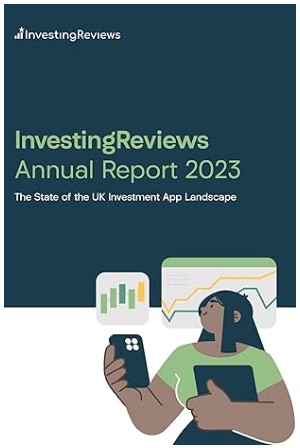Our UK investment apps survey sought to understand the different investing platforms that exist across the UK market, and how well they are servicing a diverse set of consumer needs.
We explored the different investment apps that exist, from traditional players like Interactive Investor and Hargreaves Lansdown, to newcomers like Lightyear and Wealthyhood as well as the underlying needs and wants of consumers when engaging with their investing platforms.
Continue reading extracts from our report or download the full InvestingReviews Report: The State of the UK Investment App Landscape in PDF format. Also available on Amazon Kindle.
- Executive summary – Top 10 findings
- UK Investment Apps Survey: Our Approach
- Demographics: Gender
- Demographics: Age
- Behaviours: Number of Investments
- Behaviours: Types of Asset Owned
- Behaviours: Portfolio Value
- Behaviours: Usage Behaviour
- App Preferences: Investment App Choice
- App Preferences: Number of Finance Apps Used
- App Preferences: Investment App Choice
- Final thoughts
Executive summary – Top 10 findings
- Gender split and platform skew – Our survey suggested a 70/30 male/ female investor split, and women are more likely to invest in managed portfolios, suggesting women are more savings savvy than men perhaps.
- Age – Younger investors are more likely to be attracted to app-only platforms, especially those offering free shares for recommending friends and family. What does this mean for the future of heritage investment platforms?
- Household income – The most popular apps for low income households (less than £25K annual income) are Trading 212 and Freetrade and for higher household incomes (more than £75K annual income) are Fidelity and Wealthify. Is this a reflection of their desired target market or just a natural course?
- Number of investments – The average portfolio value was £1-5K with just over 50% of our panel in this bracket. The most popular platforms for larger portfolios (£50K+) are Fidelity and Hargreaves Lansdown. Trading212, Freetrade & eToro are the most popular platforms for smaller portfolios of £1,000 or less. Are these smaller customers profitable?
- Return on Advertising – Spend Whilst big spenders on advertising like eToro dominate, this does not suggest larger portfolio values. Clearly tactics like upselling retail investors from stocks and shares to CFDs and forex trading is their aim?
- App usage – Frequency of use was high but trading frequency was not. Trade frequency was low especially amongst lower income households. Behaviour – Checking vs doing – Voyeurism perhaps?
- Net Promoter Score – Of those surveyed, the brands most likely to be recommended include Interactive Investor & Trading 212 with the least likely being Nutmeg and Wealthify. Is this a true reflection or just clients miffed with the recent bear market performance?
- Other apps used – No single investment app seems to service all users’ needs. Some have more than one app for investing and trading, suggesting that either free share offers or different assets available?
- Feature rankings – Saturation in the market suggests most investment platforms and apps are successfully meeting customer needs and offer very little other points of differentiation.
- Take note: Themes of industry – Any mergers or acquisitions will experience potential huge duplication of customer accounts where 90 percent have more than one account and with small amounts invested.

We have witnessed the stratospheric rise of new investing platforms launching and adjacent players, (including neobanks and trading platforms) broadening their services to include investing capabilities.
This growth has seen a big increase in competition as these new platforms jostle for position to acquire customers with differentiation and competitive advantage becoming ever harder.
With the rise of investment infrastructure providers such as Seccl or WealthKernel and the continued ease of access to technology, the barriers to creating investing platforms have significantly decreased. Now, new
FinTech businesses can leverage partners across their entire technology ecosystem to significantly bring down the cost and barriers of launching new investing platforms. But this comes at a cost, which we go into more detail in our report.
As we dive into this report to uncover the type of investors our market is serving, we delved deeper into how their behaviours and preferences change across different platforms and where the untapped innovation opportunities lie for the industry.
Whilst developing the research, our hunch was that whilst the UK is a global fintech leader, the market is over-served and saturated with investment apps…

UK Investment Apps Survey: Our Approach
Our research was gathered from a UK representative sample of 1,000 UK investors, sourced from Behind Login’s consumer panel.
To uncover the trends and insights from our research participants, we created a survey to understand the different types of investor that exist in the market, from demographic data such as age, gender, and income, to investor behaviour data such as frequency of trading, number of investments, and engagement with platforms.
From our research sample there were 45 different apps that participants use to invest, which is a huge selection available to UK investors and a reflection on the saturation of the market.
To ensure our research remains statistically significant we only conducted platform-level analysis on the top 10 platforms that had large enough numbers of responses to ensure confidence in our data integrity.
Our questions that explore demographic and behavioural insights leverage our entire 1,000 participants.

Demographics: Gender
When analysing the typical investor landscape from a gender perspective, we found research from Boring Money showed that there are 6.4 million female investors, compared to 9.7 million male investors in the UK; that’s a 60/40 male/female split.
Our survey followed a similar pattern, with a slightly more male bias with a 70/30 male/ female split.
Highlights
The most popular investing apps amongst women from our panel are:
- Moneybox (42% female)
- Nutmeg (41% female)
- Wealthify (39% female)
These apps all provide managed investment portfolios over individual stocks and share trading; an interesting insight into the preferences of female investors.
The least popular investing apps for females were eToro and Interactive Investor, and the more traditional investing platforms with trading capabilities, further backing up the insight that managed investment portfolios are preferable for women.
Demographics: Age
From our research, as a percentage of the total responses, the most popular investing apps for different age groups are shown in the table below:
| Age Range | Platform |
|---|---|
| 18-24 | Trading212 |
| 25-34 | eToro |
| 35-44 | Moneybox |
| 45-55 | Interactive Investor |
| 55-64 | Fidelity |
| 65-74 | Fidelity |
| 75+ | Hargreaves Lansdown |
Highlights
From our survey, evidence suggests that younger investors prefer app-first investing platforms, and older investors prefer more traditional and well-known platforms.
Perhaps this is because older investors started investing before the app-first investing platforms hit the market, and are less likely to transfer to using an investment app, and younger investors are tempted by newer platforms with better service.
Behaviours: Number of Investments
Interestingly from our panel, just under half (46%) only have 1-3 investments in their portfolio.
No. Investments
- 1 (11.2%)
- 1-3 (35.2%)
- 3-5 (19.4%)
- 5-10 (17.5%)
- 10-20 (9.6%)
- 20+ (7.0%)
Whilst diversification of portfolios has always been suggested as being critical to risk mitigation and long term investing success, it doesn’t look like consumers have taken the advice!
This might indicate that people are taking up the free fractional shares and recommend-a-friend promotions from the likes of Freetrade and Trading212, and doing little or nothing else.
However, the most popular platforms for over 10 investments are Trading212, AJ Bell, and Interactive Investor. Perhaps this is no surprise with AJ Bell and Interactive Investor being older, more traditional platforms. Better diversification perhaps and pre-app revolution?
Interestingly; Trading 212 launched in 2004 as a forex trading platform, but didn’t launch in the UK with commission-free share trading until 2017.

Behaviours: Types of Asset Owned
We asked our panel about the type of assets they hold in their investing apps.
Assets owned
- Stocks & Shares 53.70%
- Managed Funds 15.84%
- Passive Funds & ETFs 19.83%
- Foreign Exchange (FX) 2.96%
- Crypto 7.66%
Highlights
- Over half (54%) hold stocks and shares
- A third (36%) have managed and passive funds
- Only a slim percentage (10%) has FX and crypto.
Analysis
Over half (54%) hold stocks and shares, and when you compare this with the ‘total number of investments’ people have in their portfolio it identifies a serious lack of diversification (or a lot of people taking advantage of “free share” offers and doing nothing else).
Crypto and FX scored low in popularity indicating users either invest these assets on alternative platforms or they aren’t very popular with investors. This may present an opportunity for platforms to broaden their offering to include more asset types and look after more of investors’ portfolios.

Behaviours: Portfolio Value
The average portfolio value throughout our survey was £1-5K with just over 50% of our panel in this bracket.
Portfolio value
- <£1,000 (25.8%)
- £1,000 – £5,000 (24.8%)
- £5,000 – £10,000 (15%)
- £10,000 – £20,000 (11.7%)
- £20,000 – £50,000 (10.1%)
- £50,000 – £100,000 (6.4%)
- £100K + (6.2%)
The most popular platforms for larger portfolios (£50K+) are Fidelity and Hargreaves Lansdown. These are both some of the heritage platforms on the market and as such consumers have had longer to build up their portfolios. It will be interesting to see how this data shifts as the newer platforms continue to serve customers.
Trading212, Freetrade, & eToro are the most popular platforms for smaller portfolios of £1,000 or less. These companies often have low barriers to entry, low/no platform fees and often provide incentives to sign up, which might indicate why they are popular for lower portfolio consumers.

Behaviours: Usage Behaviour
In this section of our survey, we looked at the themes and common behaviours of investors. How frequently they trade, how often they check their app, and the various tasks whilst using their app.
Highlights
- Most people use their investing platform at least once a week.
- Freetrade, eToro, and Trading212 ranked as the most frequently used platforms with investors checking daily or even multiple times a day.
- 36% of investors trade monthly and 31% trade less than once a Quarter.
- The least frequently used platforms were Vanguard, Wealthify, and Nutmeg. All these platforms provide managed funds, which require less active management.
- 55% of people use their investing platform for less than 5 minutes per time.
- The most popular platforms for quick sessions of 1-3 minutes are Wealthify and Nutmeg.
- AJ Bell and Fidelity are the investing platforms with the longest user sessions of 5 minutes or more.
- Trading212 and eToro are platforms with the highest frequency traders with 34% and 35% trading once a week respectively.
Analysis
Evidence has identified that the more people trade, the worse their overall portfolios perform. Higher frequency app usage is indicative of higher trading activity and therefore puts these platforms at risk of negatively impacting investors.
It is evident that more people are frequently opening their app, checking on performance vs doing things like actually investing, buying, or selling shares.

App Preferences: Investment App Choice
In this section of the survey we asked why they chose a specific investment app, with the option to select from the list below.
What are the main reasons for choosing this investment app?
- Brand Reputation (18.1%)
- Price / Value (15.6%)
- Convenience (15.5%)
- Customer Service (15.5%)
- User Experience (14.1%)
- Recommendation (12.1%)
- Breadth of Features (5%)
- Stability & Up-time (4.2%)
Analysis
Consumers favoured brand reputation above everything else when it comes to choosing an investment app, which goes to show the power of a brand and the importance of perception. Price came in at the second most important reason to choose an investment app, indicating the price sensitivity of consumers, and the need for investing platforms to offer attractive rates.
As predicted the more traditional platforms such as AJ Bell, HL and Fidelity are favoured for their brand reputation. Freetrade customers were the only ones that cited ‘price’ as the most important factor, the clues in the name on that one. Interestingly eToro and Trading 212 both had User Experience as they key reasons for choosing their apps.
App Preferences: Number of Finance Apps Used
We asked participants, ‘aside from this investing app, how many finance* apps do you regularly use in your life?’.
*Note: Based on the responses in our survey, participants interpreted this to mean investment-specific, not general finance (10% of participants said they don’t use any other providers).
Other FS Apps?
- None (10.5%)
- 1-3 (59.9%)
- 4-7 (25.2%)
- 8-10 (3.1%)
- More than 10 (1.3%)
Highlights
- 60% use 1-3 different investing apps
- 25% use 4-7 different investing apps
- 25% use between 4-7 additional apps
- 60% of people use 1-3 additional finance platforms (in addition to their preferred investment app)
Analysis
The data suggests people use different platforms for different types of investing, e.g. funds vs shares, ETFs, ISAs etc.
App Preferences: Investment App Choice
In this section of the survey we asked why they chose a specific investment app, with the option to select from the list below.
What are the main reasons for choosing this investment app?
- Brand Reputation (18.1%)
- Price / Value (15.6%)
- Convenience (15.5%)
- Customer Service (15.5%)
- User Experience (14.1%)
- Recommendation (12.1%)
- Breadth of Features (5%)
- Stability & Up-time (4.2%)
Analysis
Consumers favoured brand reputation above everything else when it comes to choosing an investment app, which goes to show the power of a brand and the importance of perception. Price came in at the second most important reason to choose an investment app, indicating the price sensitivity of consumers, and the need for investing platforms to offer attractive rates.
As predicted the more traditional platforms such as AJ Bell, HL and Fidelity are favoured for their brand reputation. Freetrade customers were the only ones that cited ‘price’ as the most important factor, the clues in the name on that one. Interestingly eToro and Trading 212 both had User Experience as they key reasons for choosing their apps.
Final thoughts
The last few years have seen an explosion in the numbers of investment apps available to consumers, and it is likely that we’ll see options start to decline in the coming years as the winners and losers emerge.

